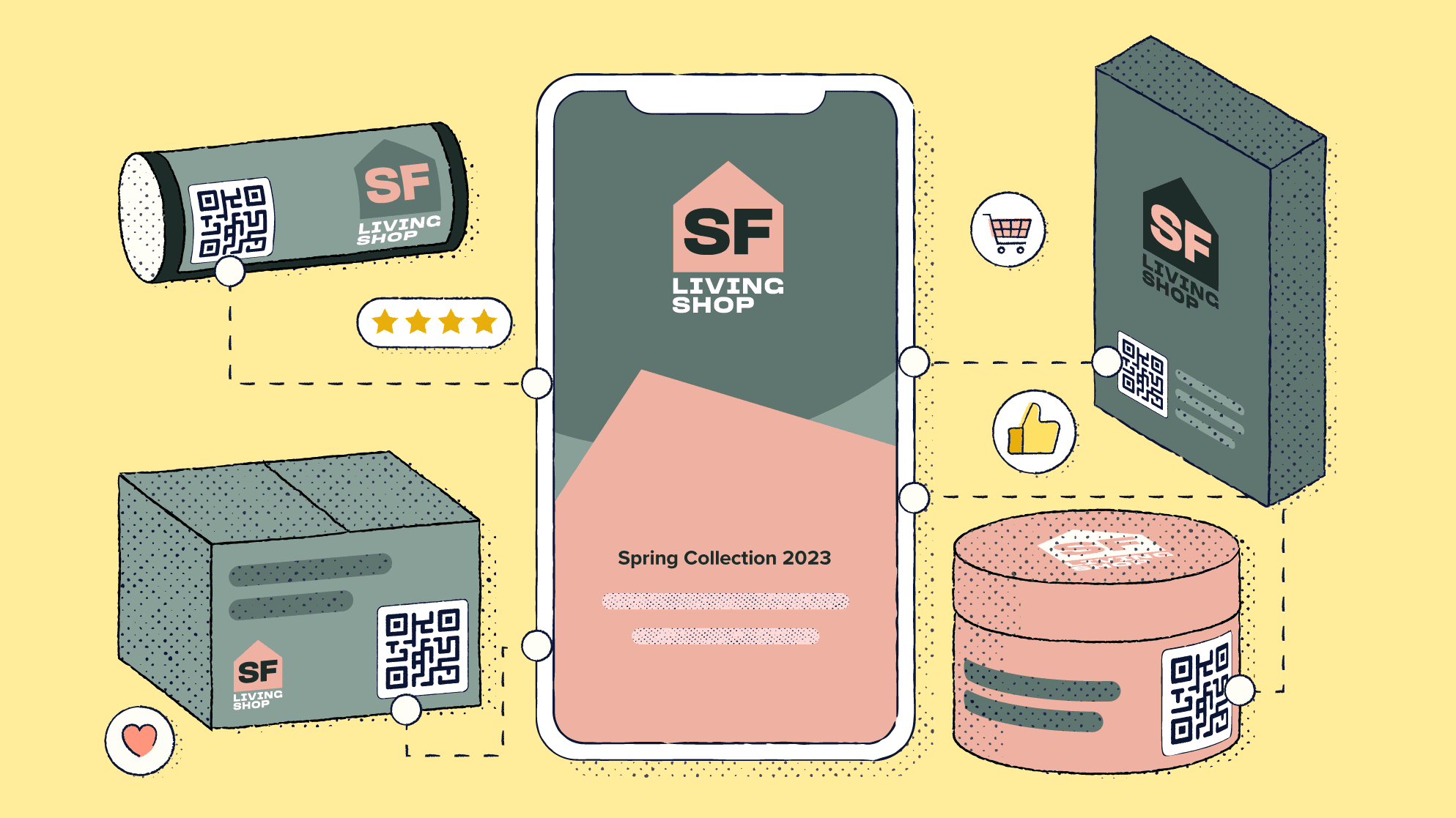
When it comes to QR Codes for product packaging, seeing is believing. In this article, you’ll discover 24 use cases and innovations showing how QR Codes strengthen customers’ brand engagement and loyalty, and also help the planet.
How are QR Codes used on products?
QR Codes are printed on products to enable consumers to easily call up a web page, video, or form. The use cases include product information pages, instructions, videos, audio, virtual reality, prefilled emails, and registration forms. QR Codes also can engage customers with promotions, special offers, and contests.
Scannable packaging helps make your brand unforgettable from the beginning to the end of your customer’s buying journey.

“Whether you call it smart, intelligent, or interactive packaging, the use of QR Codes on packaging puts your product on a trajectory that drives marketing and customer communications to new heights,” says Raleigh Harbour, President of Bitly.
“Our Bitly QR Code Index, which analyzes quantitative and qualitative data from our platform, shows no post-pandemic slowdown,” he says. “We continued to see incredible growth in the last quarter of 2022. For example, our recent data shows that product packaging scans increased by 75%, and food packaging scans increased by 59% compared to the previous year.”
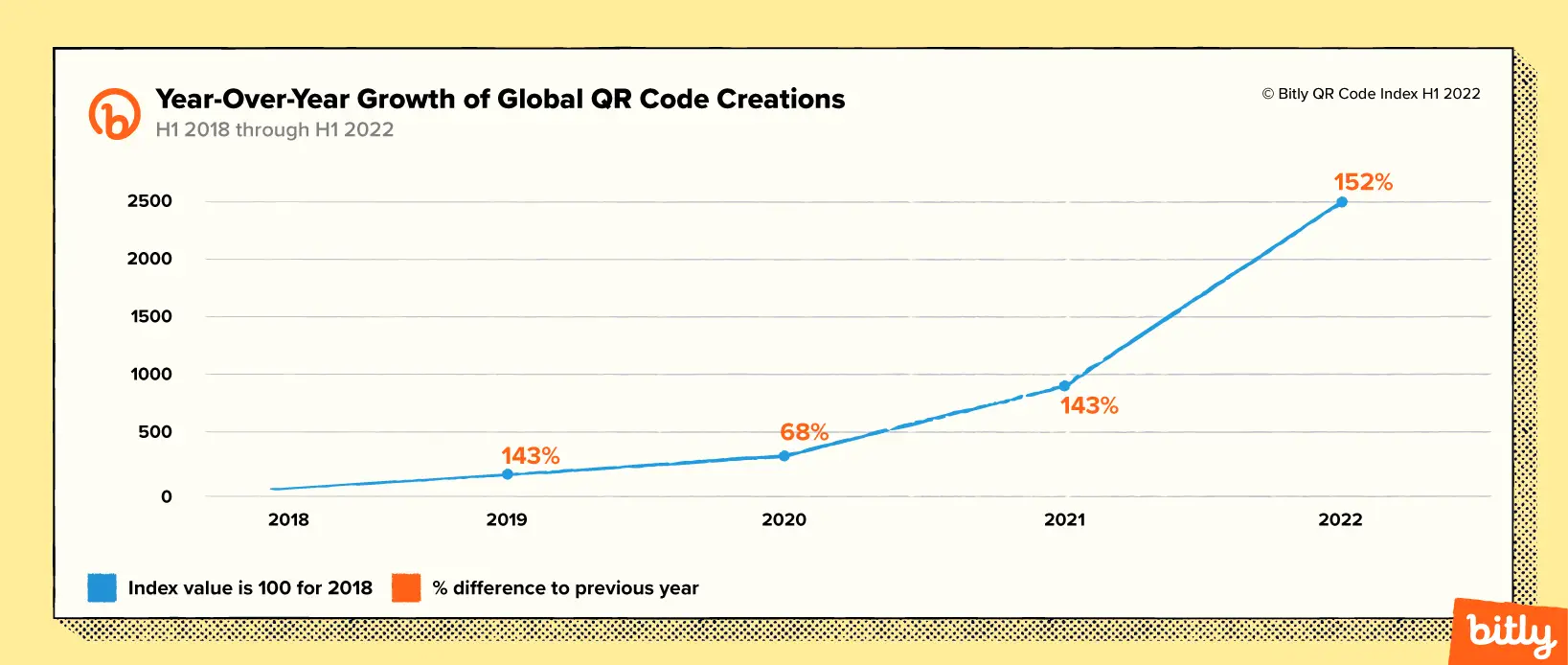
“Media-rich containers bring customers closer to companies, particularly with QR Codes,” Harbour emphasizes. “The ability to move from a box to a webpage, video, audio, or even an augmented reality experience creates indelible connections from your brand to people. That’s likely why we saw a whopping 152% growth in 2022 of overall QR Code creations compared to the same period in the previous year.”
Key takeaways
- Packaging QR Codes are a flexible, low-cost marketing tool for businesses of any size.
- The feedback, tracking, and analysis enabled by QR Codes support product improvement and strengthen marketing approaches.
- Immersive experiences generated by consumer package brands positively impact buying habits, improve safety and support sustainability.
- QR Codes with far-reaching impacts are easy to deploy with today’s sophisticated marketing platforms.
How does a product QR Code work?
A product QR Code is a matrix barcode on a product or its packaging that smartphone users scan with their camera or a scanning app. The scan immediately calls up an online page or resource about the product. Unlike a Static QR Code, a Dynamic QR Code holds data that allows for tracking and marketing optimization.
QR Codes on products have a two-dimensional pattern that sends users to web pages, videos, audio clips, signup forms, or other online resources. You can use a QR Code to add a vCard contact to a user’s phone. QR Codes can also connect to wireless networks and compose a prefilled text or email.
Dynamic QR Codes, also called editable QR Codes, offer changeable URLs and data tracking, which Static QR Codes don’t have. Dynamic Codes work by using an intermediary link, redirecting to the destination page or resource. For more details, see our guide on Static vs. Dynamic QR Codes.
Locations of QR Codes product packaging
There are three locations for QR Codes on product packaging. You can place QR Codes on the primary package, namely the product’s container. You can also place QR Codes on a container primarily used for marketing that doesn’t directly hold the product, called secondary packaging. Tertiary packaging, meaning the container used for shipping, is another reasonable placement area.
“I often place QR codes for product information on primary and secondary packaging,” comments Lilli Keinaen, Sustainable Packaging and Branding Designer at Changemaker Creative.
“QR Codes make sense since space on packages is at a premium,” Keinaen says. “Links to additional information, like a landing page with information about the product and customer service, are great for my clients and their customers. On the packaging I design, the buyer can find complete test results for 100-plus items for each batch and learn about where the product comes from.”

QR Codes offer flexibility in options to connect with customers. “I’ve also employed QR Codes on product packaging to interact and connect with the customer opening the package,” notes Keinaen. “They scan the QR Code to fill out a brief survey, or the QR Code opens up a newsletter signup form or a special coupon. One of the most exciting Codes I’ve been working on opens up an augmented reality experience, revealing an animated ‘secret message’ and experience that allows the consumer to explore the product ingredients compellingly.”
Using face moisturizer as an example, here are the three main types of packaging and how product QR codes work:
Primary packaging
Also known as retail or consumer packaging, primary packaging is in direct contact with the product. Primary packaging contains, protects, and preserves products. It’s also a vehicle to inform consumers about content, safety issues, and use instructions. Examples of primary packaging include cans, bottles, air-tight bags, or wrappers. Opportunities to use QR Codes on primary packaging make sense because the consumer sees it as long as it’s in use. For face moisturizers, the primary packaging is often a pump bottle or large jar that the customer sees daily. Although the surface is relatively small, it can still carry a QR Code.
Secondary packaging
Secondary packaging is predominantly cardboard packaging designed and printed to a high standard because of its use as a marketing tool when it sits on store display shelves. It protects the product and offers a canvas to reinforce your brand and enhance product visibility. Customers closely review secondary packaging for items like face moisturizers before a purchase. A scan of a QR Code that links to product details, couponing, and related products makes sense at this packaging level.
Tertiary packaging
Rarely seen by consumers, the purpose of tertiary packaging is usually to transport products in bulk. A QR Code on your transport boxes can still support your brand and provide company information. Tertiary packaging for face moisturizers is usually large transit packaging corrugated boxes with many surfaces and areas to display a QR Code.
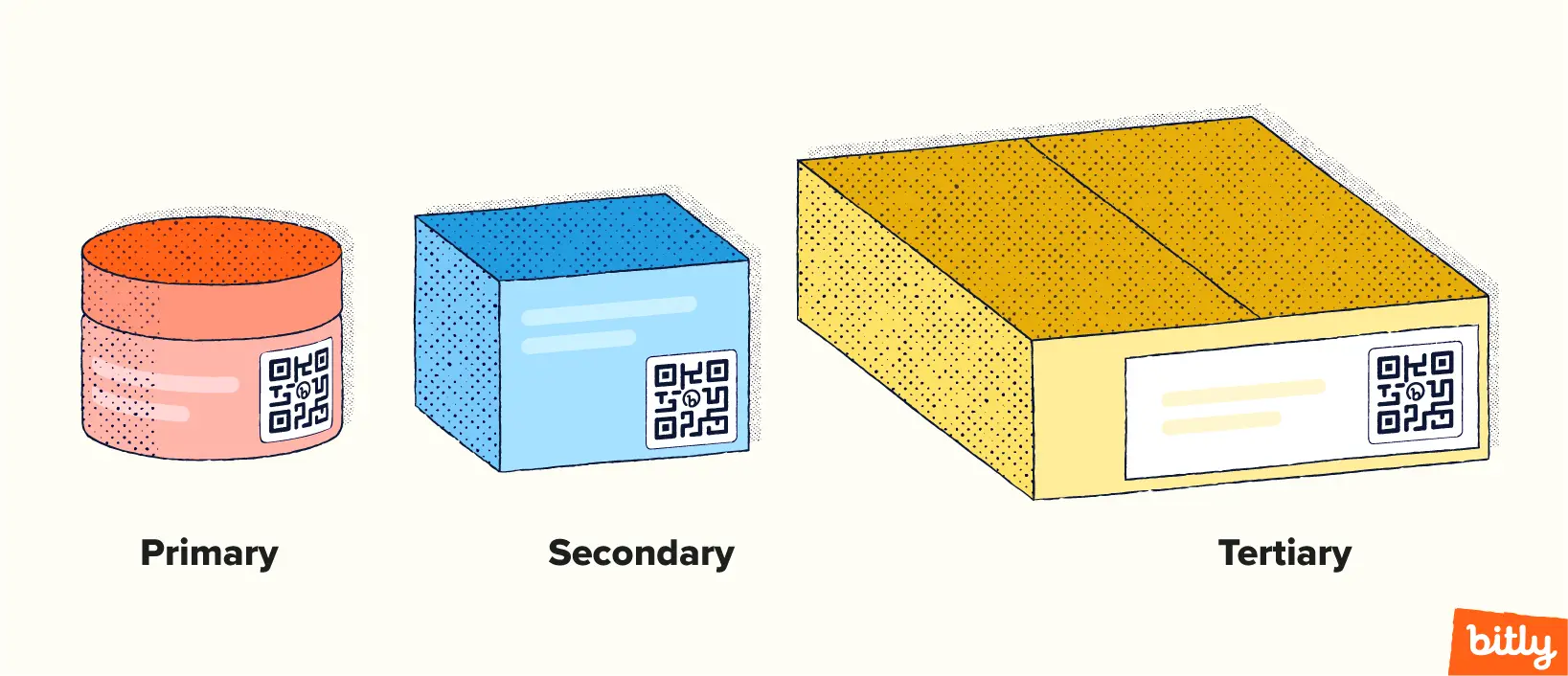
What are the different types of QR Code packaging?
The different types of QR Code packaging have varying functions. They are all smart packaging, with subsets depending on their function, and are connected, intelligent, and active. The QR Codes connect users to various types of information, create positive experiences, and improve safety.

“We use QR Codes on our sister brand SnackMagic’s cardboard vending machines,” says Shaunak Amin, co-founder and CEO of SnackMagic and SwagMagic. “Folks scan with their phones, enter their payment information and purchase the snacks of their choice. The payment then goes directly into the vendor’s SnackMagic account at an agreed-upon frequency. Tracking inventory through the QR Codes, we automatically refill snacks as they sell.”
Amin recommends taking advantage of every marketing opportunity QR Codes offer. “Always have a welcome email for incoming leads and customers to build trust and loyalty. Write in your target audience’s language using specific words, pains, problems, and slang terms. Choose an email drip program that is right for you. You don’t need to go too fancy with triggers or activities when starting, as that requires development work. You can do a quick and dirty drip using MailChimp at $10 per month or a more sophisticated one on Intercom for a lot more.”
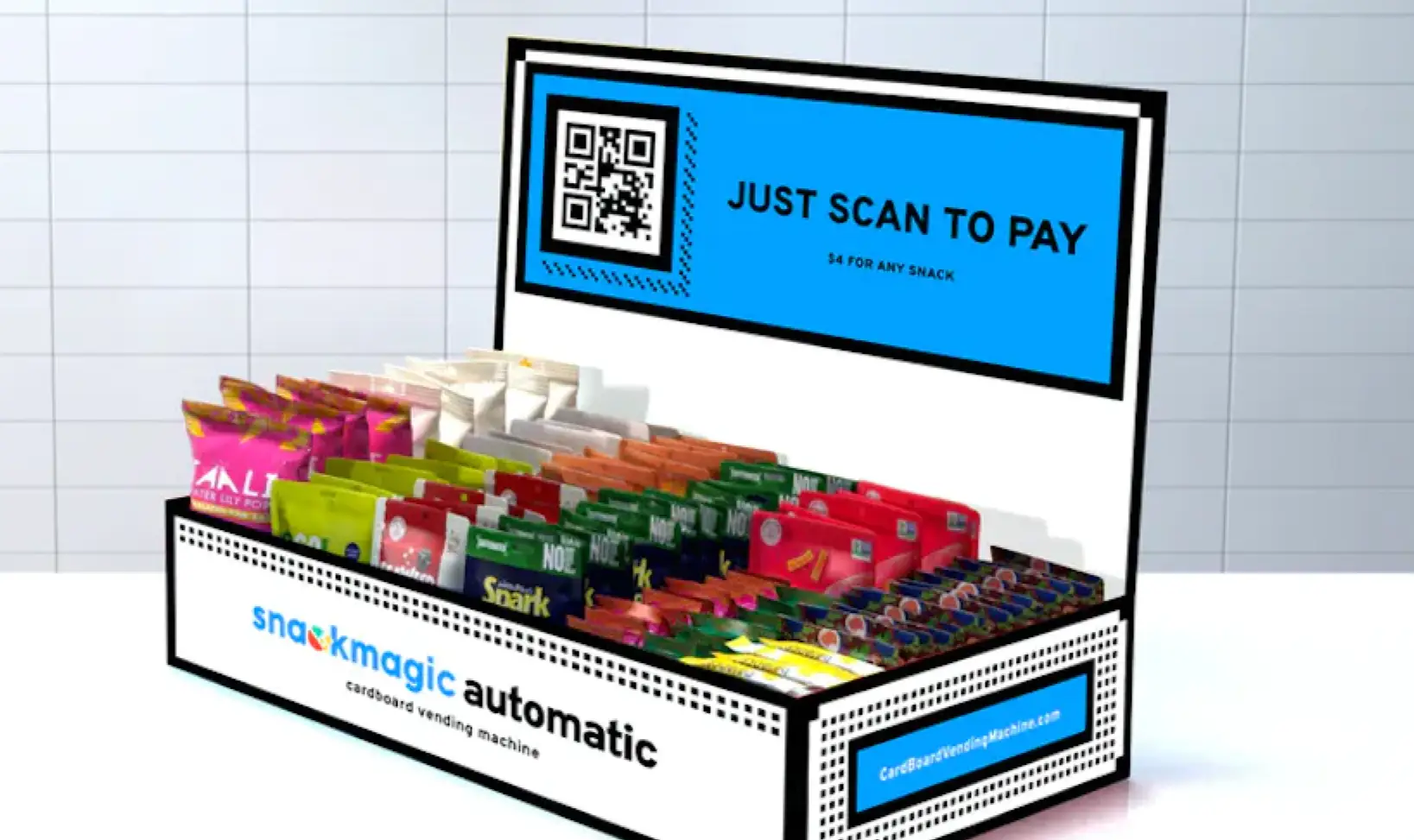
You can use the different types of packaging alone or in combination. Smart packaging is an umbrella term to describe packaging with enhanced functionality through technology. Unique QR Codes engage consumers, verify the authenticity, and trace a product’s journey to deliver valuable insights and information to brand owners and consumers.
Types of smart packaging include:
Connected packaging
This packaging connects to the cloud and the Internet of Things (IoT) to create a digital experience and increase engagement.
Intelligent or interactive packaging
Interactivity is based on electronics, including digital sensors, computational elements, and displays, usually to monitor the condition of packaged foods during storage and transport.
Active packaging
This package type interacts with the packaged product biologically or chemically. It affects the product in the pack to extend shelf life, maintain quality, inhibit fungal or microbial growth, or provide information about the product’s condition.
Why put a QR Code on your packaging?
Put a QR Code on your packaging to provide easy customer access to online resources. These can include product pages, signup forms, videos, promotions, virtual reality experiences, and more. QR Codes are environmentally friendly and simple to deploy. Also, they enable data that marketers can use to coordinate and optimize campaigns.
QR Codes aren’t sustainable only because they reduce the need for more paper or packaging. They’re also a vehicle for recycling and reusing.
“Loop is a platform that makes reuse as convenient and affordable as single-use and is available through many retail outlets worldwide,” explains Clemence Schmid, General Manager of Loop.

“QR Codes are good for reusable packaging to track each item and its journey,” Schmid says. “We are leveraging this technology and a phone-based app to enable consumers to get their deposit back with a simple scan as they return their empty packaging. Our consumer data shows that customers love using the app as it allows them to support reuse at their convenience.”
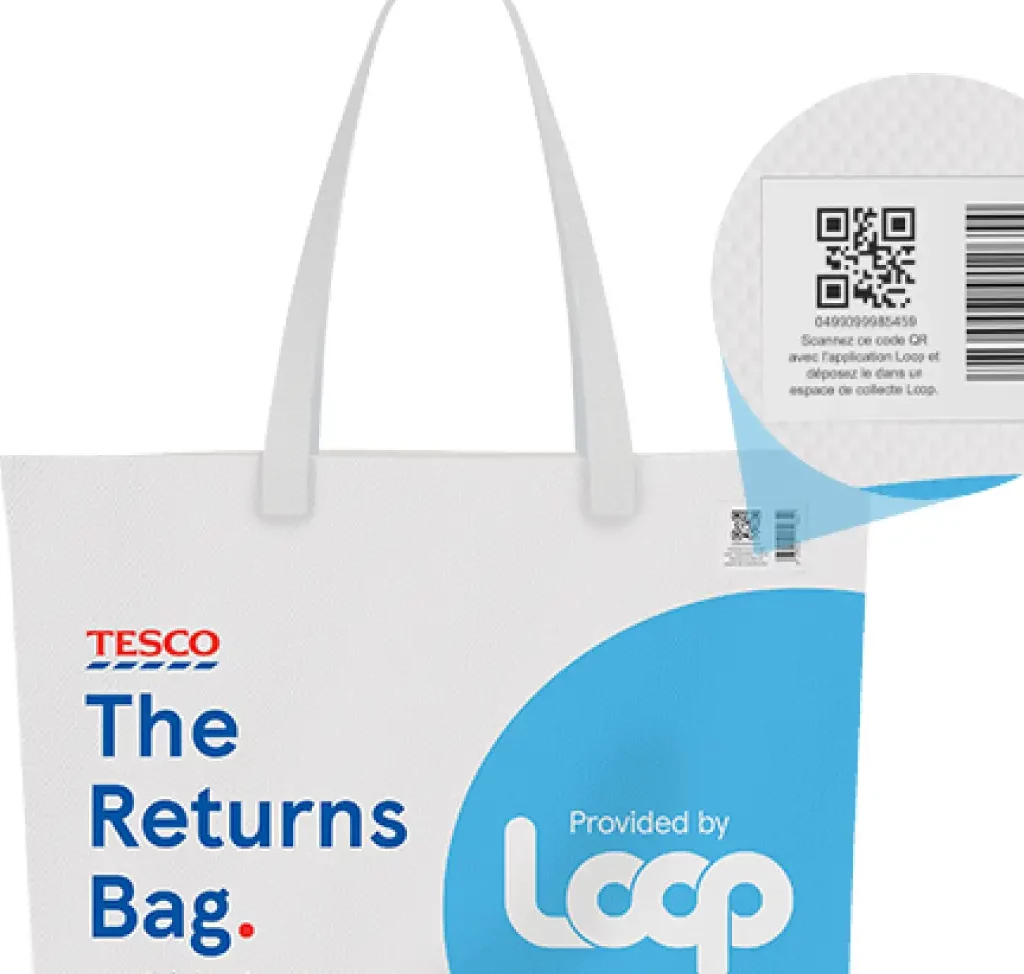
QR Codes offer multiple benefits for brands and consumers:
Sustainability
QR Codes cut down on paper product consumption, showing environmental sensitivity. Corporations still print many marketing materials, so the shift to square symbols helps save natural resources.

“QR Codes get the consumers themselves involved in the brand’s sustainability efforts,” notes Dave Rogers, Senior Marketing Manager for BlueBite, which offers brands innovative ways to use connecting technologies.
“This may mean providing easy-to-use, personalized repair, reuse or resell opportunities,” says Rogers. “For the latter, when the product connects via QR Code, the brand then has a chance to extend its sustainability story to the next owner by establishing a relationship directly with them through the individual item itself—something previously not possible. Finally, when an item has reached the end of its life, the brand can provide specific recycling instructions based on the product, the location, and more.”
“The most obvious way QR Codes impact sustainability is less need to print documents,” says Anat Baron, marketing futurist. “QR Codes cut down on paper consumption and reduce printing costs. QR Codes can also decrease the printed label size because they can provide all the necessary information through a URL, such as text, website, images, and videos.”

Baron adds, “They can provide a richer consumer experience and a deeper connection to the product and brand. Because QR Codes communicate various information to consumers, they can also tell the product’s sustainability story. Environmental impacts are increasingly important, especially to younger consumers.”
Utility
Static QR Codes have their place and are easy to generate. But Dynamic QR Codes allow you to edit the URL of your QR Codes at any point, even when packaging is complete and printed. You can change your business hours, kick off a new promotion, or add to your product line without changing the QR Code. In that case, there is no need to change the QR Code, so your customers will benefit from a consistent link.
Engagement
QR Codes encourage customer interaction and drive social platform use. “Today’s consumers demand personalization, but brands know personalizing experiences at scale is much easier said than done,” says Blue Bite’s Rogers. “Rather than using a QR Code to send consumers to a boring, static webpage, brands using a connected products platform in conjunction with that QR Code finally have the tools to easily reach consumers with the right message at the right time.”
Traceability
QR Codes for product tracking and monitoring the overall performance of campaigns are one of the most significant benefits of optical labels. You can see the report of your QR Code’s total scan count, scanner locations, when the scan took place, and the scanning device. QR Code product details allow you to give better results to your target audience, conduct A/B testing, and localize your web pages.
Security
“Security is never absolutely 100%. However, QR Codes are pretty safe by design,” futurist Baron points out. “The content inside Static QR Codes can’t be changed once generated, and the idea behind Dynamic QR Codes is that content can change. But to do so, you’d need access to the user account.”
Speed
There is no faster way to give consumers a shortcut to product information and brand than QR Codes on product packaging. QR Codes get consumers directly to information and content, customer assistance, and other help with virtually no lag time.
GS1 QR Codes are the future of product packaging
GS1, the organization behind developing and maintaining global standards for barcodes, is shifting from traditional barcodes to modern 2D barcodes like QR Codes. With a GS1 QR Code, retailers will still be able to scan the Code at the point of sale to pull up pricing information, but customers will also be able to scan it to access whatever online resources the product creator desires. GS1 is helping retailers during this transition to GS1 barcodes, and by 2027, they are aiming for mainstream adoption.
Bitly is here to support the Retail and Consumer Packaged Goods industries. Read all about our increased investment in powering connections by supporting the implementation of GS1 Standards in our products.
Use cases for QR Codes on product packaging
You can find use cases for QR Codes on product packaging in almost every industry because of their utility. If a product surface can carry a QR Code, it usually does. Use cases include retail, manufacturing, healthcare, and pharmaceutical applications.
Small and medium businesses find that QR Codes benefit their marketing efforts and customers.

“Since we are an e-commerce-based company, we want to make finding our product as simple and seamless as possible,” stresses Morgan Szekely, founder and CMO of Quirky Kin, an e-commerce coffee company for dog lovers.
“That is why we have QR smart packaging infused into all aspects of our brand. We include QR Codes on the back of our coffee bags so that when the bag is empty, customers can scan the back and quickly send a new bag to them.”
QR Codes also extend into other marketing media. “We also include QR Codes on all our branding pieces. Stickers, business cards, and even the bottom of our mugs and cups. When we do trade shows, I put QR Codes everywhere to allow people to follow our social accounts or browse our products. I have found that QR Codes for product information are a fun and seamless way to get people-specific content quickly. The more complicated or human-intensive a task, the less likely customers will do it. I want to make checking out or looking up my company as easy as humanly possible.”
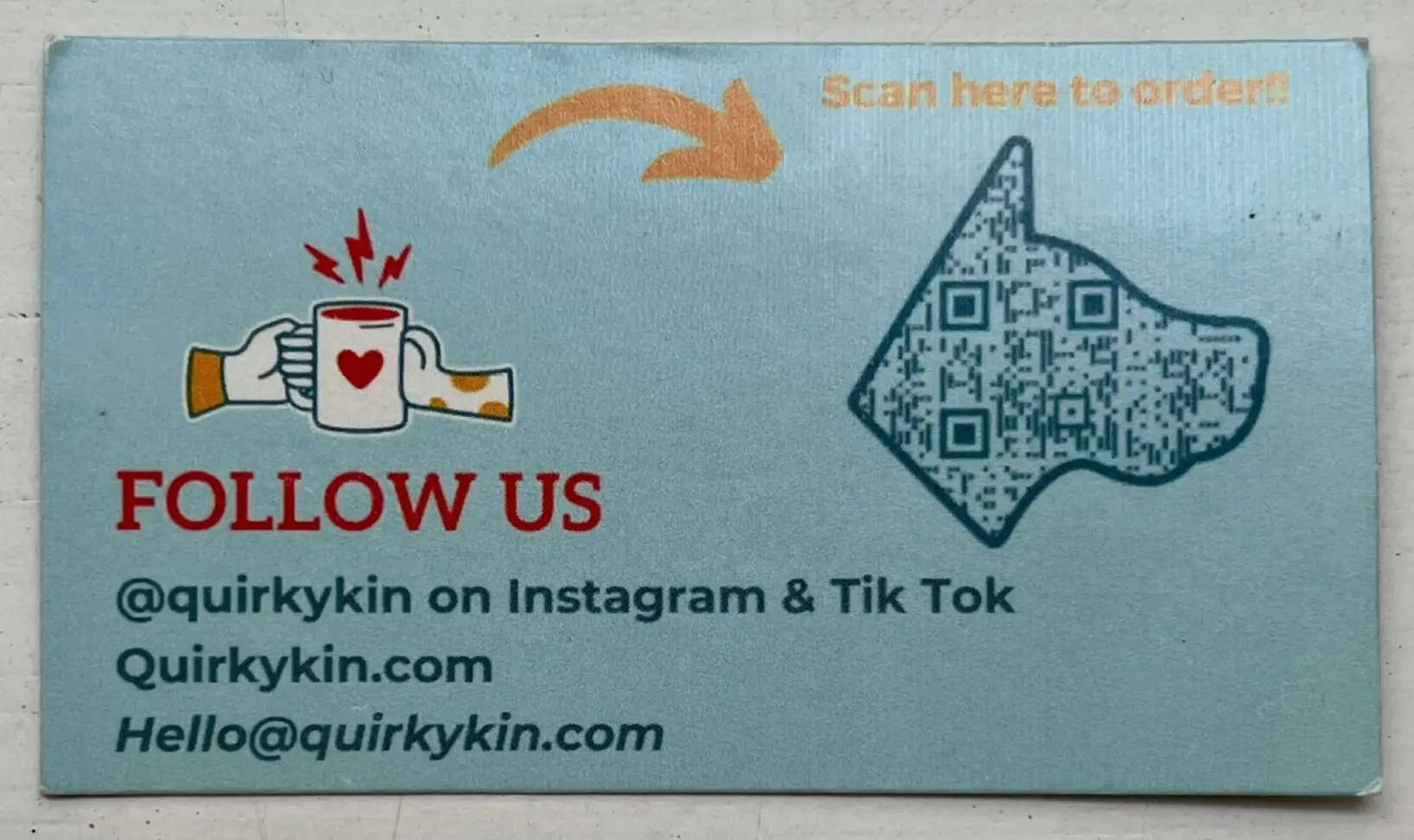
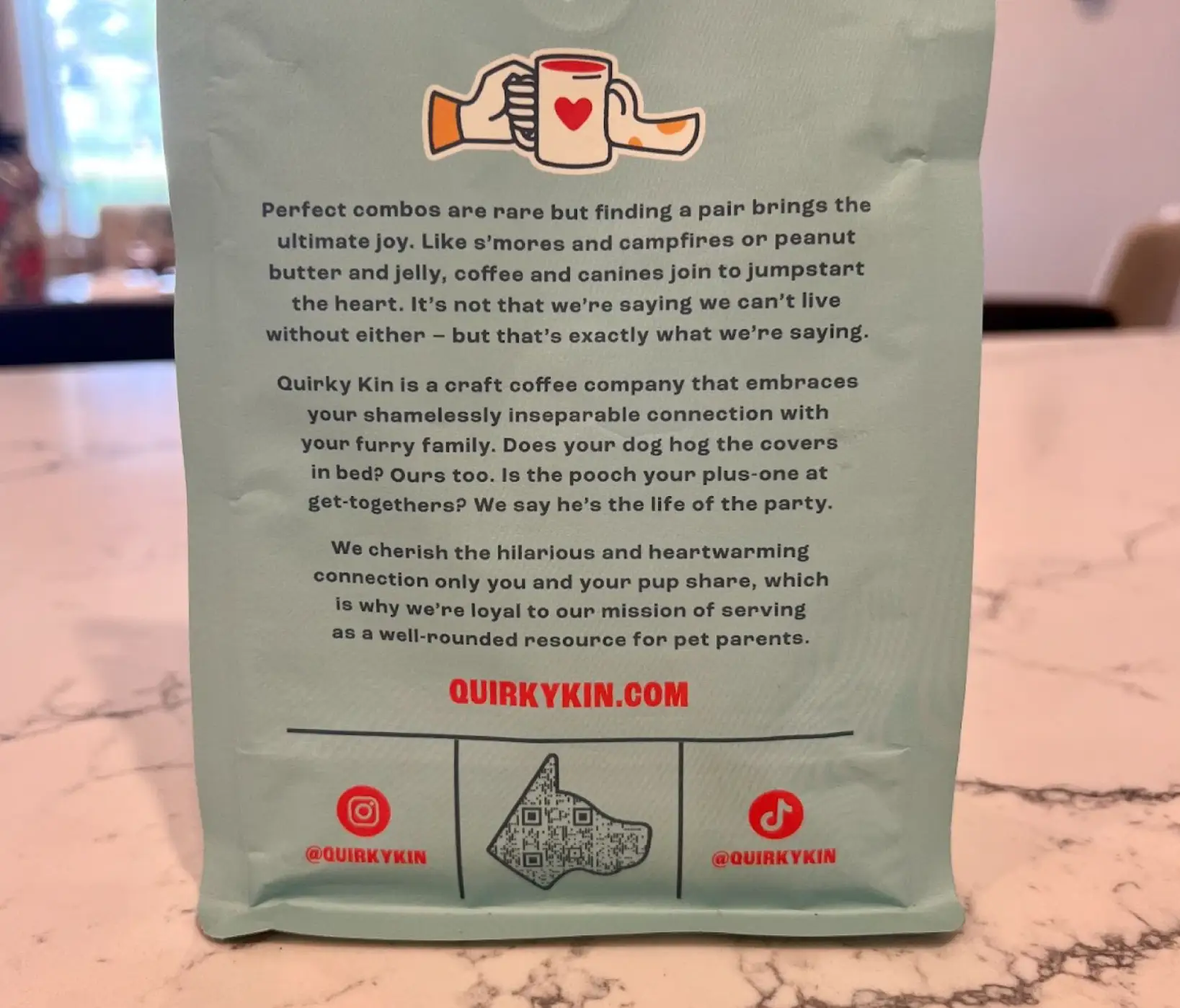
Using QR Codes for product identification, inventory, tracking, and authentication
QR Codes are scanned into inventory tracking systems to facilitate inventory easily, learn what locations and resellers are moving products, and identify and authenticate products, particularly in the luxury brand market.
Imagine a clothing brand named Second Life, whose top priority is to produce quality items with minimal environmental impact and full traceability. All their garments have a QR Code label attached to them, making them traceable. But that isn’t the only purpose for these labels. Second Life’s physical store has a scan and drop-off box for garments that customers are ready to part ways with. When customers scan the QR Code label, they get a discount on their next purchase. The scanning feature also allows manufacturers to track how many garments get returned. Returnable items will be donated to charities and nonprofit organizations to give them a second life.
Using QR Codes as an integral product feature to connected experiences
Some products make QR Codes integral to the product and customer experience. Product packaging can use a simple QR Code to provide entire experiences through augmented reality and become critical to the brand.
Tovola offers a smart countertop oven and meal kits. Tovala meal kits feature single-serving meals every week that arrive raw with simple instructions and a QR Code that the company’s smart oven can scan. The oven downloads the recipe’s cooking settings, and dinner is ready in 20 minutes or less.
“One of the beauties of the QR Code is that it enables us to do everything remotely,” says Maggie Condon, Senior Manager of Communications at Tovala.

“If a customer gives us feedback—for example, biscuits were overcooked or undercooked—our chefs go back to the kitchen, retest the recipe and if they determine the cook cycle needs an adjustment, they easily do that on the backend and optimize the dish after the original cycle.”
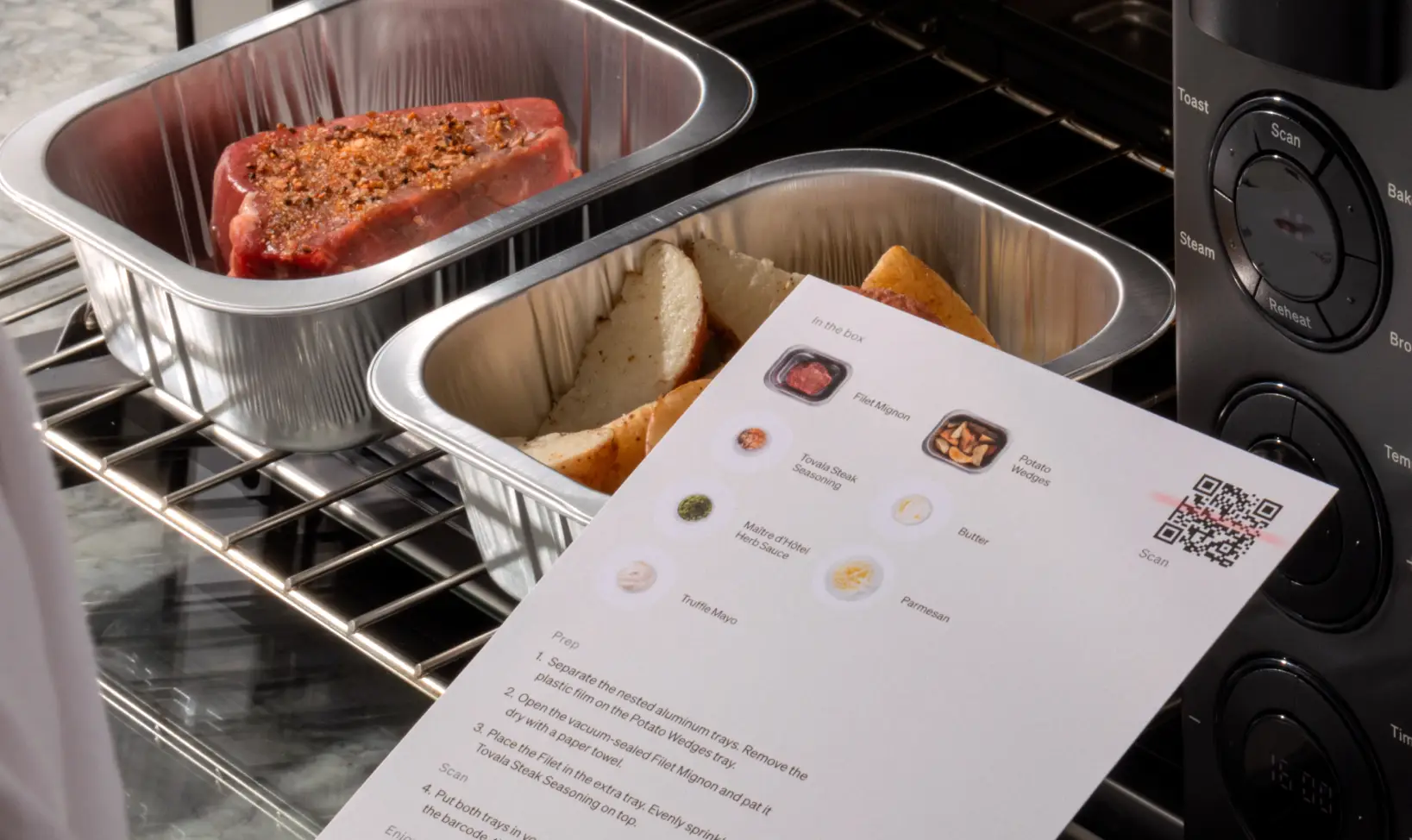
Using QR Codes on product packaging to relay more product information
QR Codes can relay all kinds of information about the product: how to use it, its ingredients, or how it’s made. Customized landing pages can redirect to download pages and multilingual product manuals and get users to videos or immersive experiences.
For example, a brand named Sautoir wanted to invite customers into the intricate process of making their jewelry. They placed QR Codes on their packaging boxes that linked to a video showing the jewelry-making process. It was a simple concept: Invite customers in on the craftsmanship to strengthen their emotional attachment to their new jewelry piece.
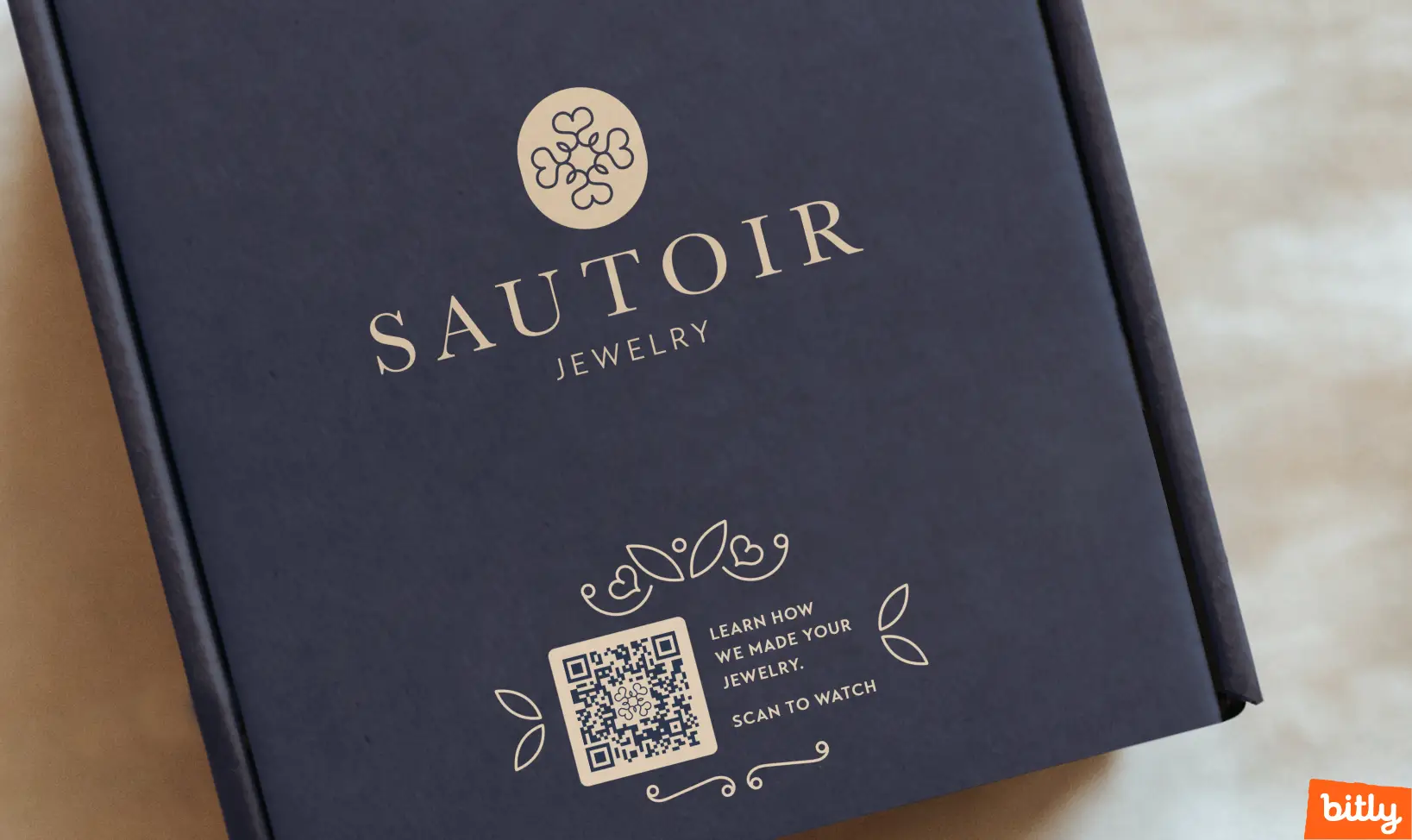
Utilizing product QR Codes to increase sales
QR Code links are the key to effective, high-speed marketing. Product coupons to get customers online or offline stores, or QR Codes that demonstrate different product uses and introduce new products increase sales for less money and in less time than traditional advertising and marketing media.
Consider a brand named Betty Baker that takes a fresh approach to cookie mix flavors. If they want to promote their new cookie flavor mix in a simple and fun way, they can add a QR Code to their packaging. When their customers scan the QR Code, they will land on an augmented reality webpage where they can explore an animated and whimsical Betty Baker universe.
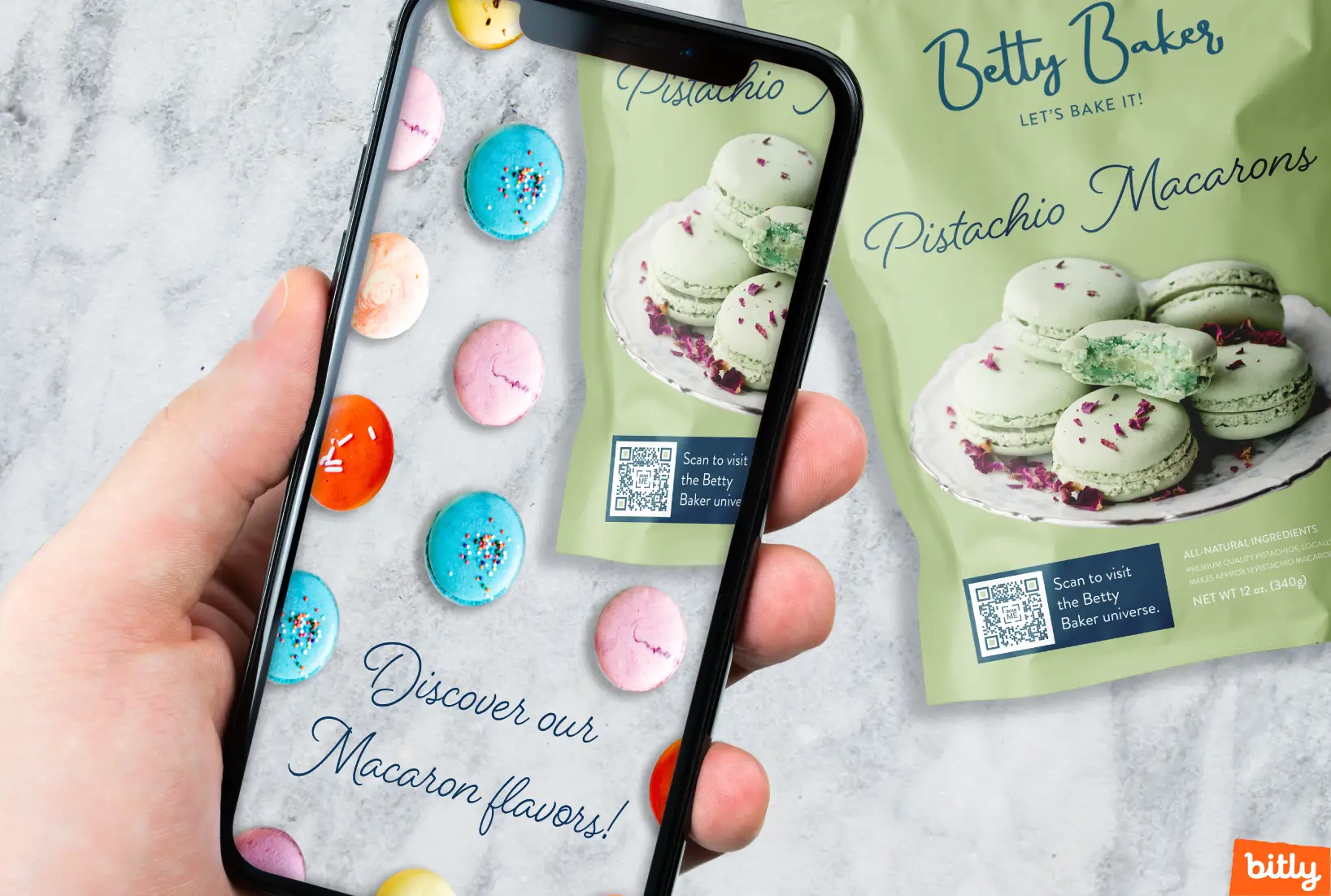
Employing QR Codes on packaging to increase customer retention
QR Codes are a valuable marketing tool to run loyalty programs or competitions, simplify product reordering, and provide customer feedback and support.
Imagine a company called Joy’s Cafe that sells organic and ethically sourced coffee. To boost customer loyalty, they can launch a competition by printing QR Codes on their takeaway coffee cups. When customers scan the QR Code they get directed to a link where they can enter the competition. Winners will receive a one-year’s supply of coffee. Scanning the QR Code is a quick way for customers to enter the competition, boosting brand engagement on the fly. Getting customers to participate in a contest is also an excellent way to build brand loyalty.
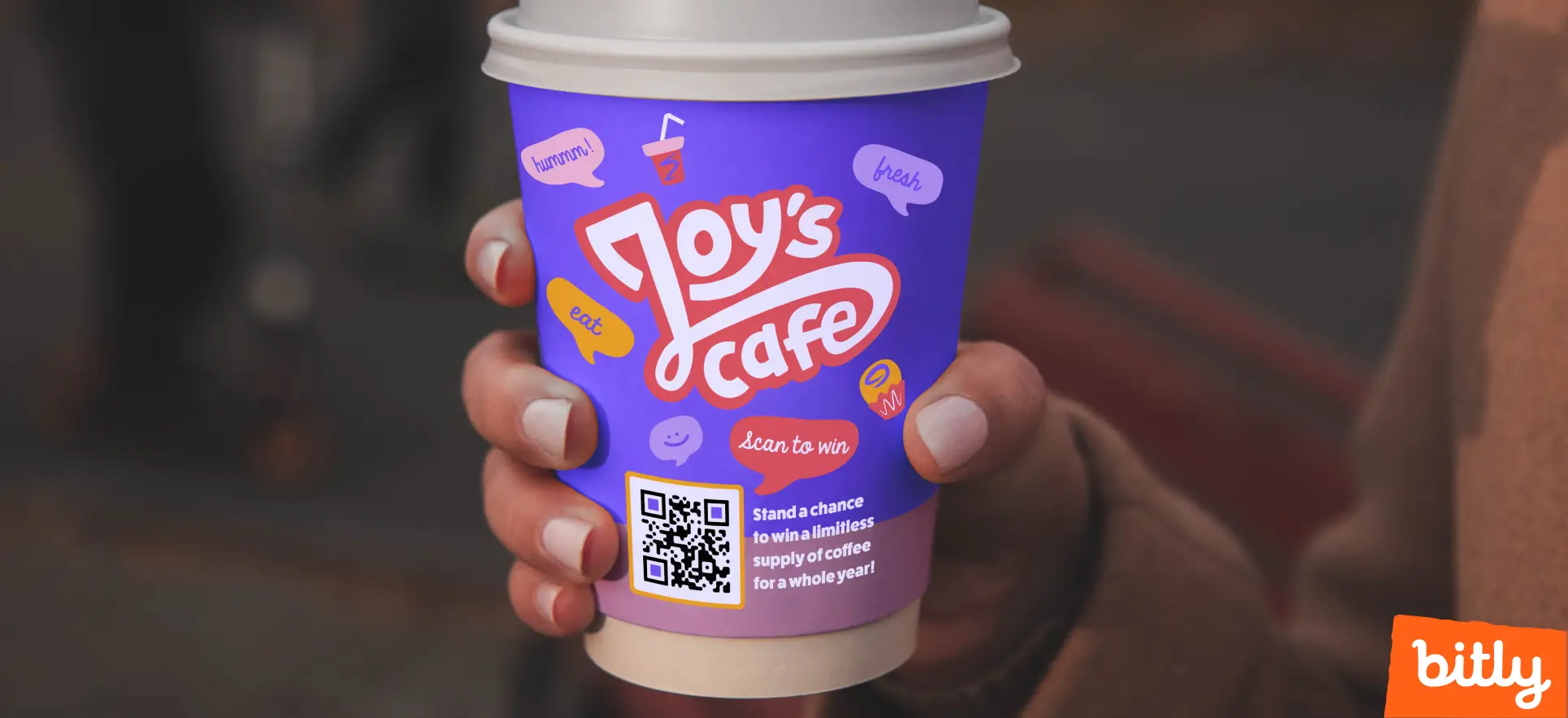
Using product QR Codes to increase customer engagement
QR Codes pave the way for links to video, social media, or immersive experiences. Subscriptions for newsletters, email marketing, and customer data gathering are some of the prime opportunities QR Codes offer on product packages.
Pro Workouts, a fictional protein brand, could develop protein supplements to support avid gym-goers with the proper nutrition to make the most of their workouts. To get more social media engagement and boost their following, they can implement QR Codes on their packaging. The QR Code allows them to engage their customers offline by directing them to their social media community.
Deploying product QR Codes to streamline customer support
You can provide customer support with QR Code links to knowledge bases, chatbots, and email forms. Since pixelated squares provide faster tracking of products, customer service is far more efficient.
Consider For Her Vitamins, a fictional company that supplies vitamins to women. In order to provide customers with access to health content and customer support, the labels carry QR Codes that can be scanned to download the app. A QR Code on labels provides immediate access to health resources and support.
Best practices for packaging QR Codes
The best practices of packaging QR Codes revolve around satisfying your customers. Engage them with clear calls to action, valuable information, personalized offers, and easy communication. Take the opportunity to move them from the physical world to a useful, engaging online experience.
Following these best practices will ensure your QR packaging Codes hit the mark and quickly show a return on investment with a highly sustainable brand and marketing tool.
“According to the Blue Bite 2022 Connected Products U.S. Consumer Trend Report, consumers seek a gateway into the world of these products,” says BlueBite’s Dave Rogers. “More than half indicated they would be more likely to buy a product if they could learn more by connecting via the packaging.”
“The caveat is that they seek relevance, and the best advice is to include a clear call to action. Inform consumers that scanning the QR Code will not take them to a static webpage they are uninterested in seeing. Instead, it will connect them to a personalized mobile experience they will derive value from, not only with the first scan but with continued visits. Often, this includes an incentivization for the first scan, such as a valuable product offer or some additional and exclusive content.”
Making the most of QR Code product packaging is simple, particularly with Dynamic QR Codes.

“Because QR Code scanning is quick, easy, and directs customers to our content, placing QR Codes on product packaging is a powerful marketing strategy,” explains Payam Karbalai, Senior SEO Specialist for Trinity Packaging Supply.
“Including a QR Code that points to our specific information enhances the value of our packaging supplies. Whether the objective is to gather customer feedback, promote social media accounts, offer additional information, or make it simple to contact customer care for a repurchase, QR Codes make marketing easier.”
He adds, “The advantages of QR Codes aren’t just for large corporations. Small and medium-sized businesses often struggle to stand out in an oversaturated market, but that is over with QR Codes. Link your customers with more of your product line, and monitor performance based on the scans. Leveraging analytics is one of the best aspects of a QR Code on product packaging. We check data of all kinds, including how many times a certain product is scanned via the Code on the box and its location.”
QR Code packaging best practices on the technical side
Technical best practices for QR Code packaging include:
Using the right size
The minimum pixelated square size on your product packaging should be 2 x 2 cm (about 0.8 x 0.8 in). You can enlarge the image if needed.
Use a Dynamic QR Code
Dynamic QR Codes create connected packaging that sends users to web pages or information like Static Codes. However, unlike Static QR Codes, the encoded URL redirects to a second URL that is changeable as needed.
File types and formats
QR Codes can be created and saved in various bitmap and vector formats and then downloaded in formats such as PNG or JPEG.
Mobile optimization
People use their phones to scan, so test that platform first to ensure it’s mobile-friendly.
Test for readability pre-deployment
Usually QR Codes redirect perfectly; sometimes, they do not. Make sure you have multiple people with various tech-savvy levels to try the process before you launch.
Track impact post-launch
Track whether the web address you use for your QR Code is getting more traffic than before deployment. Gauge effectiveness by tracking the number of scans by date, time, and country.
Retarget
Retarget people who have scanned your QR Code on sites like Google or Facebook.
Customer-focused QR Code best practices
Focusing on the customers means thinking about what they want and satisfying that desire. That includes worthwhile calls to action, clear instructions, and engaging content.
“We work with Redken to help them deliver experiences customized to the brand,” explains Blue Bite’s Rogers. “We personalize for each consumer depending on where they were in the product journey, what language they spoke and many additional contextual factors.”
“When consumers scan the QR Code on the shampoo package with their phone, they launch a connected product experience for specific product recommendations for other products they would love. We also include incentives to revisit the experience. This way we create a long-term relationship and build enduring value for both consumer and brand.”
Customer-focused best practices include:
Add a call to action
Add a call to action near or in the QR Code.
Make the action worthwhile
A coupon, offer, or early launch information is an excellent reason to use QR Codes. Even if you don’t always use QR Codes for discounts, viewers will get used to checking out the QR Code.
Communicate the value
Let customers know why they should act, then deliver the promised value.
Instruct consumers on scanning QR Codes
Make directions accessible and clear.
Minimize the number of steps
QR Codes work for you and your customer only if they require the fewest steps possible to get to the happy ending.
Creative QR Code packaging best practices to make products memorable
“I own an all-natural skincare store with two locations,” shares Terri-Lynn Woodhouse, owner of One Earth.

“One location is in a tourist area where we have many first-time customers. Reordering is fundamental to us. We recently updated all of our product labels with QR Codes prominently displayed on the products. The Code links to the product on our website to make it easier for our customers to reorder with just a couple of clicks. We’re thrilled that our repeat sales numbers have dramatically increased.”
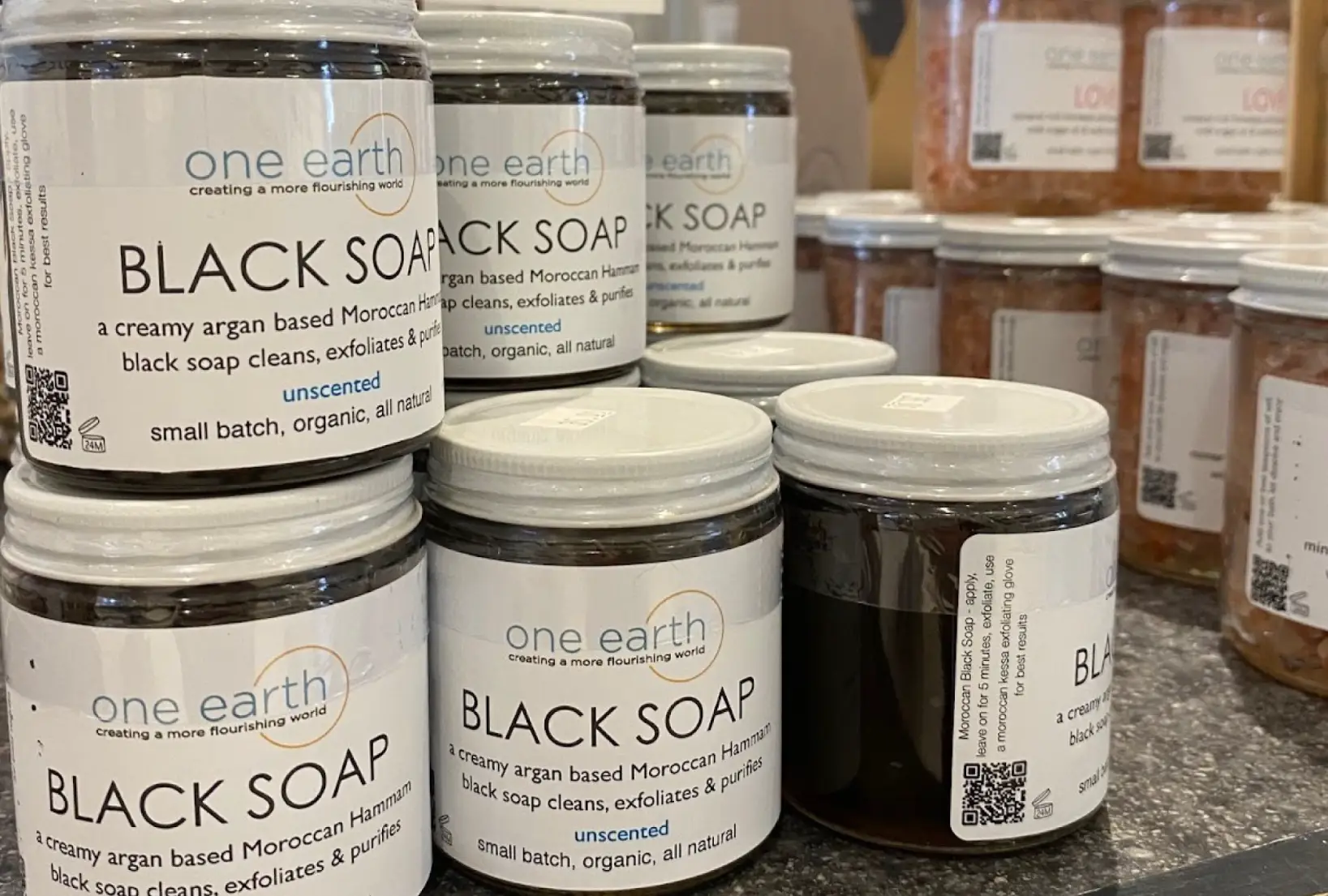
Here are creative best practices for QR Codes:
Focus on placement
Make sure your QR Code is easy to spot, not placed on a fold or corner. Also, don’t place it on an area of packaging that reflects the light.
Use a distinctive shape and content
Plain squares aren’t the only way to shape your QR Code. Use brand details, a different shape, icon, text, or even an engraving directly on the product if it is wood, metal, or plastic.
Add a logo inside your QR Code
Incorporate a logo at the center of your QR Code for maximum impact.
Add color
Incorporate your visual brand color palette. Use contrasting colors for the best legibility.
Add a call to action inside your QR Code
Add a call to action like “Find us” or “Like us” on your QR Code.
Have a purpose
Ensure you’re using QRs for the right reasons—to improve customer experience or a specific marketing goal, not because it’s trendy.
Think green
Save paper with instruction manuals, marketing materials, guarantee and warranty signup, coupons, and more. You can do more with online materials for greater sustainability.
Combine with other tactics
Some people won’t love the pixelated squares no matter what you do, but it’s good to reinforce messages and campaigns with everything at your disposal.
Keep it fresh
Update information, fix mistakes, or make your website seasonally relevant. Keep it appropriate, exciting, and accessible.
Check for success
Marketing campaigns are useless if you don’t have the data to back up the win. Check-in periodically on your QR Codes to track campaign success by using a tool like Bitly Analytics.
Which companies use QR Codes on product packaging?
Post-pandemic, QR Codes have become ubiquitous. Today, over 90% of consumer product brands, from Fortune 500 companies to e-commerce start-ups, use QR Codes. Consumers have come to expect them, and they offer marketers multiple promotional opportunities.
The “4 QR Trends for 2022” in Flexible Packaging Magazine reports that 92% of consumer product brands place QR Codes on their product packaging, and 20% use them to direct consumers to sustainability information about the product. Proof of the coding boom lives in “Food and Beverages Coding and Marking Equipment Market: Global Industry Trends, Share, Size, Growth, Opportunity and Forecast 2023-2028,” which reports that the worldwide market size reached $1.6 billion (in U.S. dollars) in 2022 and is expected to reach $2.2 billion by 2028.
Examples of companies using QR Codes on product packaging
Here are 10 examples of consumer packaged goods by fictional companies doing exciting things with QR Codes. Learn how you can do the same for your brand.
- Tool & Co is a company that manufactures premium toolboxes and storage products. They printed a QR Code on the product packaging to appeal to a broader customer base, especially to those who are still unfamiliar with various tools within their toolbox. The QR Code links the customer to a PDF guide containing video tutorial links for each tool. This empowers customers to use the tools in their toolboxes more confidently. Another benefit is that the company uses less paper since they don’t need to print out instructional manuals.
- La Pâtisserie Macarons is a French-owned bakery that specializes only in macarons. As part of their marketing strategy, they use QR Codes on their packaging to establish a more personal connection with their online audience. By scanning the square, customers were taken to a video that told the story of the brand, inviting them to learn more.
- The Good Farmer, a family-owned and mission-driven company, committed to supplying fresh, organic local produce to supermarkets and wholefood stores. As a way of driving more engagement and offering consumers a sense of their brand, they include interactive QR Codes on their packaging. In the event a consumer scans the square, they will be directed to The Good Farmer’s website which offers discounts, videos, and other brand-related content.
- Nature’s Cleanse is an eco-conscious brand that makes body soaps with the utmost care for the environment and for the skin. They gave their packaging the ultimate makeover by printing QR Codes on their product packaging. The QR Codes were implemented to improve brand transparency so that consumers could be more aware of the ingredients in their products. Consumers who scanned the square on the body soaps were directed to a website to learn more about the ingredients. In doing so, customers empower themselves to make thoughtful purchases—and at the same time build more trust in the brand.
- Sip Now is a wine brand focusing on sustainable and recyclable packaging. In order to raise public awareness about the importance of recycling, the brand launched a QR Code campaign. The wine company uses pixelated squares on their wine containers to direct people to their Instagram page for the launch of their campaign. This way, the brand could get more traffic to the social media page and start a conversation with them online.
- Jumping Joe has printed QR Code labels on their packaging to incite more interest in their brand. When they looked closely at their TikTok analytics, they noticed more engagement in their reels—particularly the ones that involved more rope tricks. This sparked an idea; if they could connect their packaging to their TikTok account, they could potentially increase not only traffic to TikTok but also sales in their jump ropes.
QR Codes were the missing puzzle piece. By printing QR Codes on their packaging, consumers could follow their TikTok account and learn some new skipping rope tricks, making it more of an interactive experience for their customers. - Setting up a laptop, phone or tablet can be intimidating, especially for the technophobes of the world. In order to assist their customers when setting up devices for the first time, Digi Electronics found the perfect solution. By using QR Codes, customers can simply scan the square which directs them to a link to download their app. Through the app, customers can either chat with customer support directly or access video content that helps them set up their devices. QR Codes make it easy for customers to get in touch with the resources they need in a more efficient way.
- These days people who have beards are searching to the ends of the earth to find the right products to grow their beards. Bearded Folk wanted to become the one-stop shop for beard-related growth products, so they launched a new product range called the Beard Growth Box. When customers open this box, they’ll find a range of products designed to stimulate hair growth, including a razor and oils for post-shave. They’ll also find a QR Code to prompt them to snap a selfie of a cleanly shaven face in this box. Using Instagram, customers can upload it and tag them, bringing offline packaging to online social media. For Bearded Folk aims to boost social media engagement by personalizing its packaging.
- Tea Infusions is a herbal tea company that swears by the health benefits of drinking tea daily. To drive this message home they decided to offer their customers coupons by placing QR Codes on their packaging. Whenever customers run out of their favorite tea, they can easily re-order them by scanning the QR Code on the packaging and redeeming the discount. That way customers will never miss out on extracting all the health benefits their daily tea ritual has to offer and the company will be able to increase sales.
- Finding the right shade of lip gloss while you’re in a store can be time-consuming. For this reason, FEM Lips uses QR Codes on their packaging so customers can virtually test the lip gloss shade without physically touching it. Trying on lip gloss allows customers to select their favorite shade by scanning multiple shades until they find their perfect match. With the QR Code, customers can test new brands or shades and feel more confident about their purchase.
How to create a QR Code for a product
You can easily create dynamic, visually appealing QR Codes for your product with Bitly. Be sure to have your company color HEX codes and company logo ready.
Follow these steps to create a QR Code for your product:
- Sign up for a free Bitly account or log in if you already have one.
- Select the blue Create new button in the top left corner and select QR Codes or hit the letter Q on your keyboard as a shortcut.
- Fill in the Destination URL, and optionally a Title and Custom back-half.
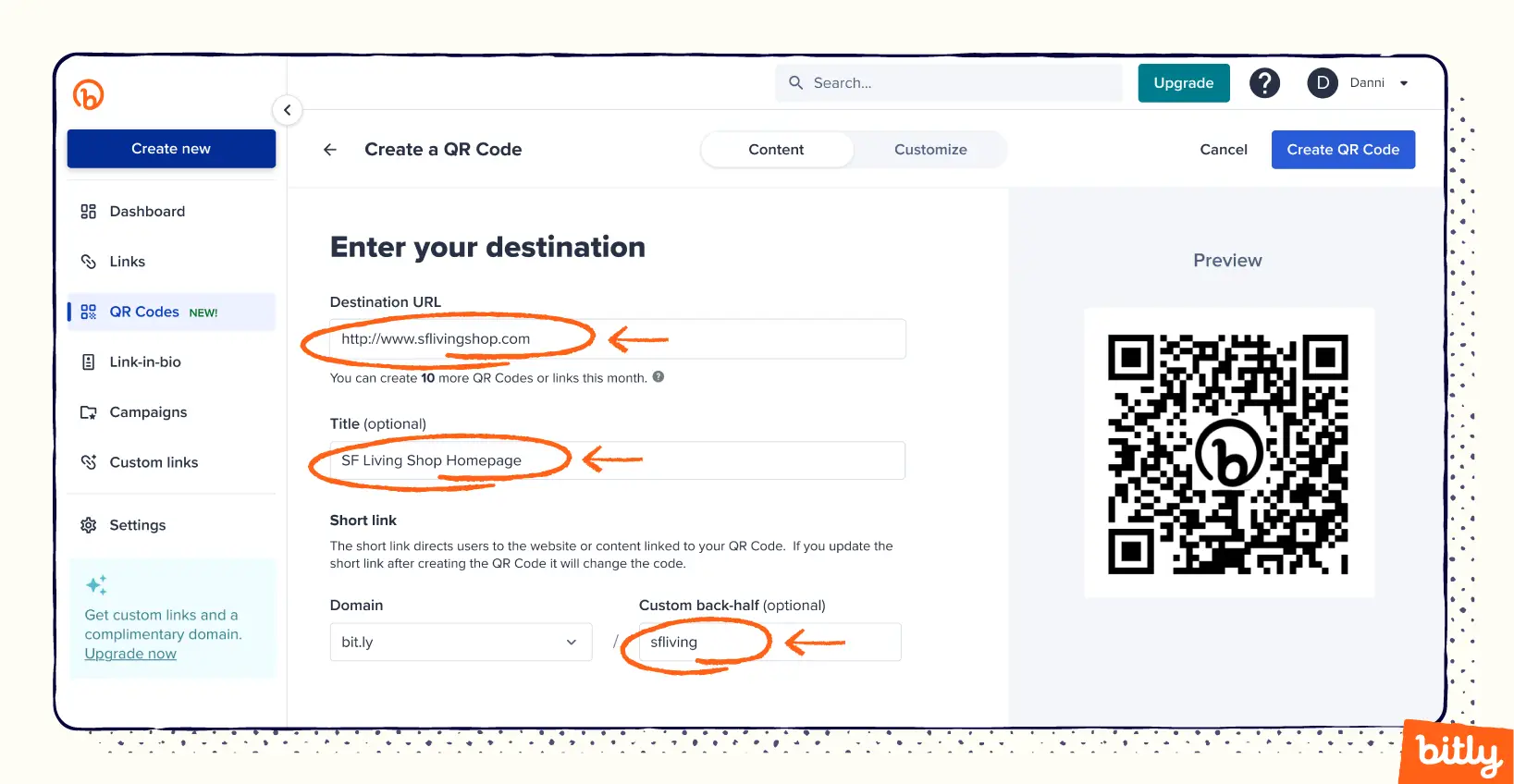
- If available in your plan, customize your QR Code by adding your brand color and uploading your company logo, or use one of the available social media logos. Select Create QR Code when you’re done.
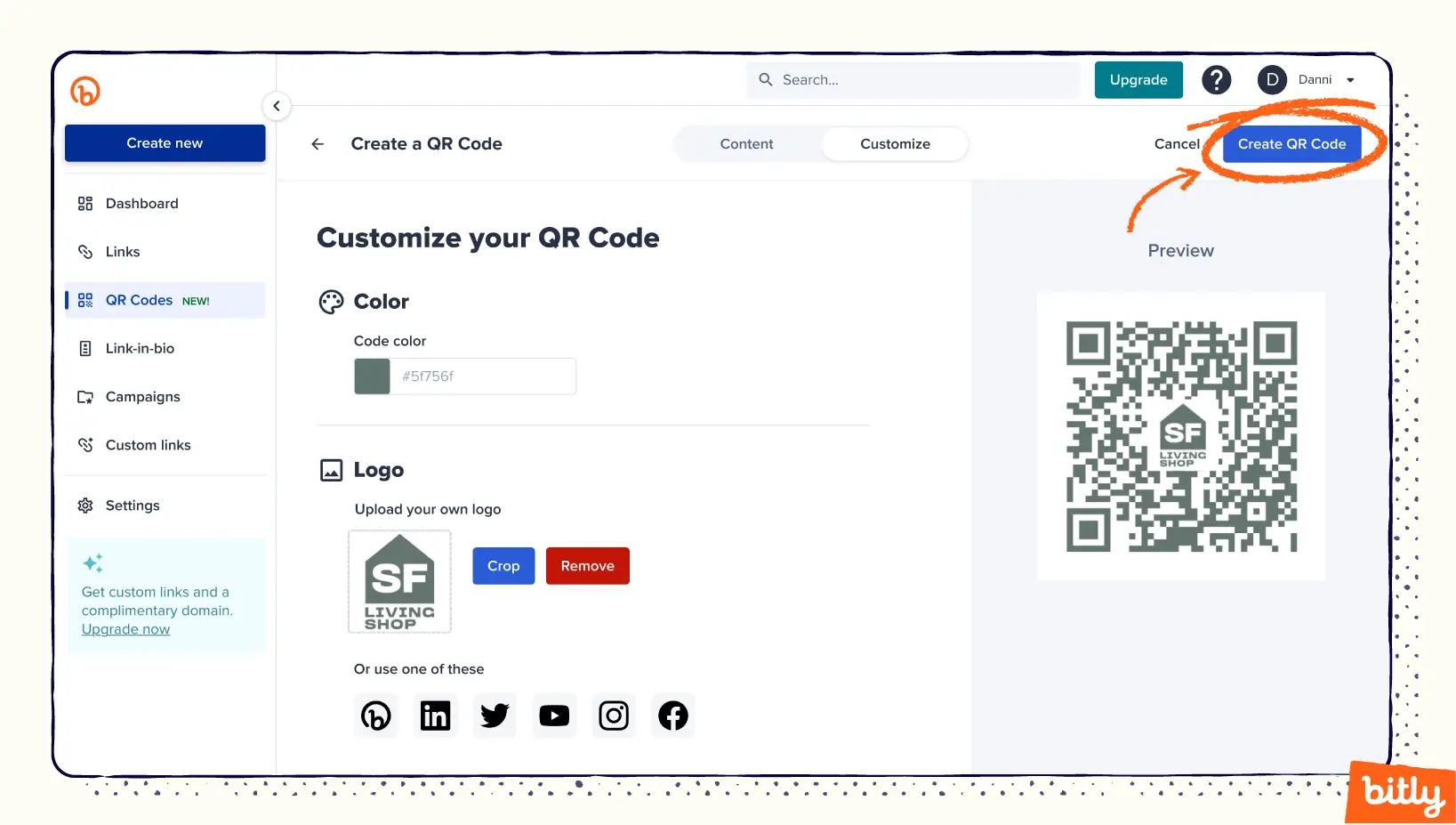
- Your QR Code can now be used on any product packaging by downloading it in one of the available formats.
Efficient and advanced QR Code marketing with Bitly
Take control of your QR Code marketing with the Bitly Connections Platform—our single platform for Link Management, QR Codes, and Bitly Link-in-bio—and engage your customers, one scan at a time. Bitly is the partner that makes your marketing and business strategy even more brand consistent. The Bitly Connections Platform also enables you to understand your audiences and bring them a more focused experience over time with access to scan metrics. Gain insights and optimize campaigns to nurture customer relationships.
Find out which Bitly QR Code solution is right for you, from simple black and white squares to advanced QR Codes for product packaging for multimedia formats, including audio, video, and PDF.